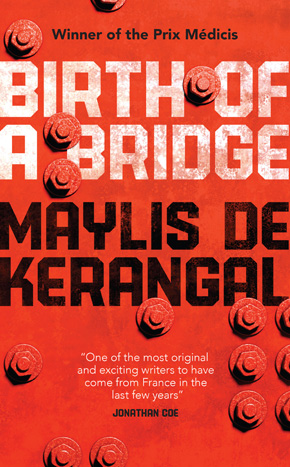A monumental construction
by Mika Provata-Carlone
“A fast-flowing, meandering river of awesome depth, scintillating with flashes of brilliance.” Martine Desjardins
Maylis de Kerangal’s Birth of a Bridge by is a strikingly original contemporary myth and a thrilling investigation of post-modernity.
The story is simple, absorbingly technical, full of tactile details and well-grounded practicalities. In a realistically imaginary city in California called Coca, a powerful mayor who has climbed to the summit of success from the pits of powerless anonymity, yearns for his new-found status to be set in stone. To that purpose, he conceives of a massive public work, a bridge to straddle the river that divides the city’s shores. The project is demanding, Herculean, gargantuan, and can only be realised with the contribution of international construction companies, conglomerates, multi-coloured and multi-ethnic tribes of workmen and specialists converging on Coca with that single aim, the Birth of the Bridge.
Each migrant worker, each peregrinating adventurer and cosmopolitan technician comes with a unique name full of the echoes of other lives, different histories and revolutionising undertakings. Names are neither haphazard nor accidental. Nor are they fortuitous. Some are ominous and foreshadowing. We have the enlightened George Diderot, lost mystic Verlaine, transcendental drifters Ralph Waldo and Katherine Thoreau (none of whom seem to understand what their names stand for, what titanic references they bring). Then there is the mayor, a pat John Johnson, a.k.a. ‘the Boa’, and female engineer Summer Diamantis, representing the hard-working, odd-one-out, high-achieving second- or third-generation immigrant. In direct contrast to the solidity, resonance, momentum and significance of the names are the lives – and even the bridge itself. Infinitesimally small lives, bursting with redundant or cluttering details, or painful, empty and blank, like a hallucinatory trip with neither beginning or conclusion. The bridge – its design, its geological and socio-political and urban planning and the minutiae of its construction – is the same: it has as much or as little purpose, serves in as essential or superfluous a manner the flux and the crux of life.
The novel has a strong picaresque quality as well as a masterly epic Western dimension. It is a quest for something unnamed, something unknown, symbolically embodied by the bridge, with powerful impetus and thrust, both narrative and verbal, a constant sense of mobility –and at the same time stagnation. Physical movement is contrasted to existential suspension of life’s vital rhythm, and the stress throughout is on the separation between the key elements of Bergson’s élan vital: there is non-vital momentum and craving for vitality free from constant impetus. As with the mobility and disjunctive effect of names, this is a novel, a narrative, a philosophical and anthropological analysis which moves like a maelstrom, with the inherent premonition of a cosmic purpose. There is a sense of millions of heterogeneous, autonomous molecules forming one disintegrating organism, all in collision course, propelled in space, time, humanity – a humanity “euphoric and stupefied”, that essentially “spits with rage into the mirror that reflects [it].”
Rags and tatters of humanity, greater and lesser men and women, have been drawn here in their state of amnesia or nebulous remembrance erased and replaced with something identically murky, directionless and inscrutable.”
The picture of the world that de Kerangal conjures – magnificently, breathlessly, intoxicatingly – is a picture of dire meaninglessness and occasionally deep, troubling horror. It is also a picture too familiar to dismiss as fiction. First, she pulls together the disparate threads of her tapestry, the snippets of stories or the lingering echoes of memories or nightmares. These lead her to the master story, the eye of the maelstrom. Rags and tatters of humanity, greater and lesser men and women, have been drawn here in their state of amnesia or nebulous remembrance because of a past that the Boa wishes to erase – in order to replace it with something identically murky, directionless and inscrutable. Halfway through the narrative, a crime occurs: a violent, unpredictable, unstoppable act which ruptures the fine civilising fabric of the bridge. A wise white man living with the ostracised natives leaps literally out of the jungle in a trance of righteous resolve and stabs Diderot, the master builder of the edifice. He then disappears as mysteriously and mythically into the world of trees, nature, wilderness, savagery and primal wisdom. “This livid man who rows [the dugout] with his back straight as a rod, his black tie like an Ottoman sabre across his chest over the white shirt, the dark velvet scholarly jacket, the white socks poking out of moccasins, where did this guy come from?” His name too is titanic: he is Jacob, patriarch of the native tribes.
Diderot survives as Jacob disappears, and the slash of the latter’s knife opens up a slit through which to bring back history and memory. We are taken back to the time of the early settlers and told the story of how the West was won – we are taken back to what is assumed to be the beginning of time for the real and the fictional land of the novel. Violence, struggle, deceit, sacrifice, famine and stark determination are the elements of that cosmogony, a combination of features and of experiences that each generation strove hard to both remember and forget. Each civilising layer had less clarity – yet, as de Kerangal argues throughout, still possessed all of the potential of good and evil from which it was born. The ultimate layer is the Boa. He wants to “be done with [the] erudite conceit [of Old Money], their culture, their archives, too much Europe, he repeats this time and again, heavy identity, sticky traditions, it stinks of death.” The Boa (and are we not surrounded by Boas?) “wants to build the city of the third millennium, polyphonic and omnivorous, doped up on novelty, shaped for satisfaction, for pleasure, for the experience of consumption.”
The Boa’s violent need to do away with the old and to bring in a faceless, unclaimed new has the same source as his demand for the experience of things as opposed to experience itself. The world he desires, fights tooth and nail to build, is the world of sensations as opposed to senses and emotions, a world where entitlement to power is bereft of vision and responsibility. It is a narcissistic, self-reflexive world, a labyrinth of self-reference, solipsism, greed and utter loneliness. An autofiction. The Boa’s bridge becomes in de Kerangal’s hands a foundation myth for a new cosmos without past or memory, only newness, power, monumentality. It is also an aetiological fable explaining the state and void of our own society as mirrored in this fictional, dysfunctional, realistically unreal community.
Maylis de Kerangal is one of the most beautiful and dynamic writers that France has produced in a very long time. She has the relish of words and of storytelling of all those who came before her in her craft.”
Boa the Bridge wishes to force together the wilderness of an unexamined, emaciated, cast-off past with the wasteland of an at best tangential skimming of experience and existence in ever-present time. Between the two shores of past and present, under the Boa’s bridge, runs the river, the powerful, eternal and ineluctable flow of being and non-being. For de Kerangal the writer, anthropologist and mythographer, the river itself is the natural bridge we no longer have the skills to see. In an interesting redefinition of the sequential relationships of time and chronology, this constant flux and friction between past and present is none other than the future. Man can either submit to its natural primitive powers (like Jacob), adulterate and falsify it (like the Boa) or recreate it. We do not have an example of this in the narrative –perhaps because the novel emerges as the ultimate redeeming act of truly civilising restoration. What we have at the end of the novel is the escape of two lovers, Diderot and Katherine Thoreau, down the river, into time – with neither promise nor denial of a future.
Maylis de Kerangal is one of the most beautiful and dynamic writers that France has produced in a very long time. She has the relish of words and of storytelling of all those who came before her in her craft: clearly Flaubert and Balzac for social acuity, Proust and the writers of the nouveau roman for the fluidity and thrilling choreography of language and plot, certainly Duras, Dostoyevsky and García Márquez or Borges for the sense of how to retell reality so as to give it a new-born quality and enchantment. There is Camus, Steinbeck, Faulkner, perhaps the verve of, say, Margaret Atwood or Philip Roth, above all there is sparkling new writing and old quality in whatever she creates. The Birth of a Bridge is her first novel to be translated into English – powerfully and elegiacally by Jessica Moore – and there is no doubt that it will mark a change in perception, in appreciation, in humanity, in readers and writers alike.
 Maylis de Kerangal is the author of the novels Je marche sous un ciel de traîne (2000), La vie voyageuse (2003), Corniche Kennedy (2008), and Naissance d’un pont (2010), winner of the Prix Franz Hessel and Prix Médicis, and now translated by Jessica Moore as Birth of a Bridge. She has also published a collection of short stories, Ni fleurs ni couronnes (2006), a novella, Tangente vers l’est (winner of the 2012 Landerneau Prize, and the fiction tribute to Kate Bush and Blondie Dans les rapides (2007). In 2014 her fifth novel, Réparer les vivants, won the Grand Prix RTL-Lire and the Student Choice Novel of the Year from France Culture and Télérama. She lives in Paris. Birth of a Bridge is published by MacLehose Press on 2 July. Read more.
Maylis de Kerangal is the author of the novels Je marche sous un ciel de traîne (2000), La vie voyageuse (2003), Corniche Kennedy (2008), and Naissance d’un pont (2010), winner of the Prix Franz Hessel and Prix Médicis, and now translated by Jessica Moore as Birth of a Bridge. She has also published a collection of short stories, Ni fleurs ni couronnes (2006), a novella, Tangente vers l’est (winner of the 2012 Landerneau Prize, and the fiction tribute to Kate Bush and Blondie Dans les rapides (2007). In 2014 her fifth novel, Réparer les vivants, won the Grand Prix RTL-Lire and the Student Choice Novel of the Year from France Culture and Télérama. She lives in Paris. Birth of a Bridge is published by MacLehose Press on 2 July. Read more.
Author portrait © Catherine Hélie
Jessica Moore is an author and a translator based in Toronto. A former Lannan writer-in-residence and winner of a PEN America Translation Award for her translation of Turkana Boy by Jean-François Beauchemin, Jessica’s first collection of poems, Everything, now, was published by Brick Books in 2012. She is VP for Ontario for the Literary Translators’ Association of Canada and is also a singer-songwriter – her debut solo album, Beautiful in Red, was released in 2013.
Mika Provata-Carlone is an independent scholar, translator, editor and illustrator, and a contributing editor to Bookanista. She has a doctorate from Princeton University and lives and works in London.

